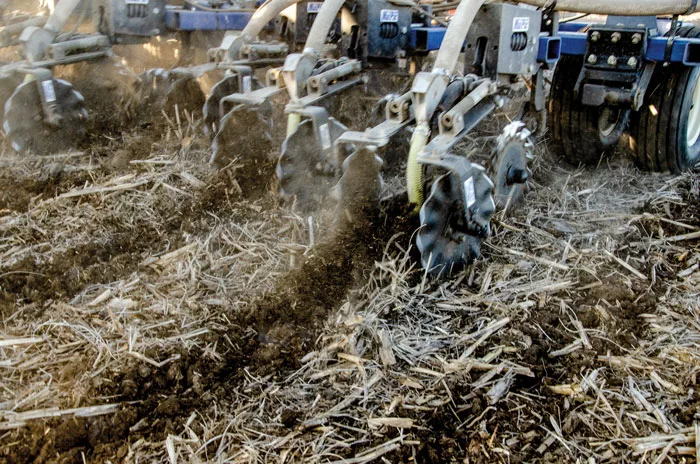The use of precision technology continues to grow for conservation-minded farmers according to No-Till Farmer’s 16th annual No-Till Operational Benchmark Study and Strip-Till Farmer’s 11th annual Strip-Till Operational Benchmark Study.
Compared to 2022, more no-tillers plan to use all categories of precision technology listed in the survey, with the exception of variable-rating fertilizer. Only 31% of no-tillers are going to variable-rate their fertilizer in 2024, compared to the 35.1% in the 2022 survey.
GPS tractor auto-steer remains the top precision tech tool, with 69% of no-tillers planning to use guidance in 2024, a near 9-point increase from 60.5%. Over half (56.7%) will use yield monitor data analysis, a 10-point increase from 2022. Nearly half of no-tillers will use auto-boom or nozzle shutoffs, followed by field mapping (46.3%) and auto seed shutoff (41%).
Dan Forgey, a 2022 No-Till Innovator award recipient and agronomy manager of Cronin Farms near Gettysburg, S.D., is not surprised by the increasing popularity of precision ag, as its use has been aggressively adopted and used in his region for a long time.
“I would guess right now that 75% of the acreage in these 2 counties are variable-rate application,” he says.
He figures at least 1 acre on each end of the field gets overlapped if technologies like auto-shutoff and row guidance are not in use.
“I don’t think it takes very much for it to pay for itself,” Forgey says. “I believe that’s a trend that’s nothing but better for farming because it makes you so much more efficient.”
27.3% are using satellite aerial imagery, 26.7% GPS Guidance-Lightbar, 26% variable-rate seeding, 18.3% GPS Implement Guidance, 17% drones and 3% remote sensing.
A total of 426 no-tillers took the survey, with most being located in the Corn Belt (45.2%). 19.2% of survey respondents farm in the Lake states (Minnesota, Wisconsin, Michigan) and 13.9% are in the Northern Plains (North Dakota, South Dakota, Nebraska, Missouri). Less than 10% of respondents were either from states in Appalachia, the Northeast, the Mountains, the Southern Plains, the Pacific, or the Southeast.
Strip-Tillers Increase Technology Usage
More strip-tillers than ever are also using precision technology according to results from the 11th annual Strip-Till Operational Benchmark Study.
90.2% are using GPS tractor auto-steer in 2024, almost 30% more than the 2023 survey (60.5%). 72.2% are using yield monitor data analysis, compared to only 46.7% in 2023, and 60.9% are using auto-seed shutoff and field mapping, both numbers up considerably from 2023 when only 39.3% used auto-seed shutoff and 44.5% used field mapping.
Veteran agronomist Michael Petersen, a former NRCS soil scientist and independent consultant with over 35 years of strip-till research experience, isn’t surprised by those numbers at all.
“Precision technology makes a huge difference,” Petersen says. “If farmers can get their heads wrapped around being able to use all the tools that come out of GPS and the technology that comes from the combine, it makes a huge difference. Those numbers (rate of adoption) are going to improve even more, I think."
Petersen predicts more strip-tillers will look at adopting see and spray technology soon.
“The growers I work with are looking to improve their weed control,” he says. “There are new tools that only spray the weeds and nothing more, allowing farmers to save a lot on herbicide usage. I think that’s going to be the next big thing for strip-till.”
59.4% of strip-tillers surveyed are using auto-boom or nozzle shutoffs, 45.9% satellite aerial imagery, 44.4% variable-rate fertility, 41.4% variable-rate seeding, 27.8% GPS implement guidance, 24.8% drones, 11.3% GPS guidance-lightbar, which was down 14 percentage points from 2023 and 5.3% are using remote sensing.
A total of 215 strip-tillers took the survey, with most farming in the Corn Belt (50.3%). 22.3% farm in the Lake States, 9.5% in the Northern Plains and 5.6% in the Northeast. Less than 13% of respondents were either from states in Appalachia, the Mountains, the Pacific, the Southeast or the Southern Plains.





![[Technology Corner] Autonomy & Robotics Take Center Stage](https://www.precisionfarmingdealer.com/ext/resources/2026/01/12/Autonomy--Robotics-Take-Center-Stage.webp?height=290&t=1768253759&width=400)


